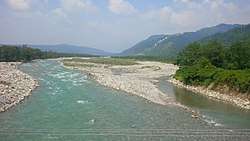Song River (India)
The Song River is a river in Dehradun district that drains the central and eastern part of the Doon Valley, in the state of Uttarakhand, India. A tributary of Sooswa river, which in turn is a tributary of the Ganges, it originates as spring-fed stream in the southern slopes of the Radi Top of Mussoorie ridge of the Himalayan range and runs from Dhanaulti towards Narendranagar.[1] As is common in hilly areas, there are several streams running south from the mountains that merge into one river that emerges from the hills a little after Sahastradhara.

Song is one of the largest rivers that drain the Doon Valley traversing 190 km (120 mi) , and its tributaries includes, Kali Gad, Shahastradhara, Assan River and Rispana River.[1][2]
Shahastradhara
It is a popular scenic spot for the locals, based on the banks of a tributary of the Song, the Kali Gad. It was more famous for its healing sulphur springs but is now more of a picnic spot with families crowding the waters in the summer.
Hydrology
The Kali Gad merges into the main Song river east of the Kalinga Hill. After this confluence, the Song is a broad river valley, larger than its western counterpart - The Assan River . The river now flows through the valley in a south-eastern direction passing through the regions of Harrawala and Doiwala. It is a perennial river, however the water surges during the monsoon as can be seen from the bridge at Doiwala. The river proceeds southward till it merges with the Sooswa river.
The Sooswa in turn originates from the southern Shivalik range separating the Doon valley from Saharanpur district and Haridwar district, collecting water from several small streams, including the once perennial Rispana. It flows westwards to Doiwala and can be seen through thick forest from the train running from Haridwar to Dehradun. The river then flows through the forest of Kansrao before its confluence with the Ganges at Raiwala.
References
- Sharad Singh Negi (1991). Himalayan Rivers, Lakes, and Glaciers. Indus Publishing. pp. 117, 127. ISBN 978-81-85182-61-2.
- Vishwas Balasaheb Sakhare (1 January 2007). Advances in Aquatic Ecology. Daya Publishing House. pp. 1–. ISBN 978-81-7035-483-3.